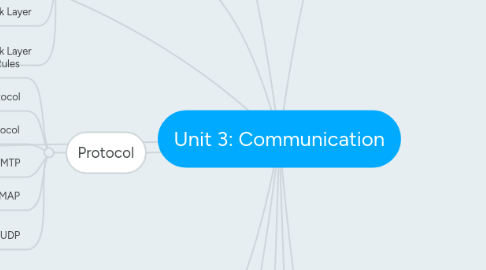
1. Advantages and Disadvantages
1.1. Advantages
1.1.1. Sharing resources such as printers saves money
1.1.2. You can access your files from any computer in the network
1.1.3. Data is easy to back up as it is stored centrally on the server
1.1.4. Use of messaging or email across the network
1.2. Disadvantages
1.2.1. Purchasing the network hardware is expensive
1.2.2. Managing a large network is complicated
1.2.3. Virus attacks on the network may infect every computer
2. WAN, LAN and PAN
2.1. LAN
2.1.1. Local area network uses cables and networking equipment owned either by one person or business at one local site or a group of nearby buildings
2.2. WAN
2.2.1. Wide area network use third party cables over a wide geographical area
2.3. PAN
2.3.1. Personal Area network uses a Bluetooth connection to connect headphones tablets and speakers
3. Packet and circuit switching nework
3.1. Circuit switching uses one single route/cable and is susceptible to interference and failure of one section results in the entire failure
3.2. Packet switching uses many different routes and resulting in the data being split up into packets then reassembled at the other end
3.2.1. Each data packet will contain the same number of bytes decided by the NIC and each packet is marked with the total number of packets
3.2.2. Lost packets, the recipients computer uses check sum to check for lost packets. Packets after a set time will be automatically be resent
3.2.3. Nodes/ routers pass the packet through the path that is least busy
4. DNS Domain Name Sever
4.1. DNS converts a web address into and ip address e.g www.google.com = 74.125.131.94
4.2. There are 13 main (root) servers that have a complete database of all names and IP adresses
5. IP addressing
5.1. Every computer and other device connected to the Internet has an private IP address given out by the router
5.2. ISP give each router a public IP address which can change over time
5.3. Packets are labelled with the senders and destination IP address
6. MAC addressing
6.1. Media Access Control is assigned to each NIC by the manufacturer a device can have two MAC addresses one for WIFI one for Wired
6.2. Every networked device has a unique MAC address
6.3. MAC address never changes IP does depending on loaction
7. Protocol
7.1. Set of Rules
7.2. FTP File Transfer Protocol
7.2.1. Used for sending files like file explorer
7.3. HTTP HyperText Transfer Protocol
7.3.1. HTTPS encrypts information
7.4. SMTP
7.4.1. Simple Mail Transfer Protocol
7.5. POP3 IMAP
7.6. UDP
7.6.1. Doesn't check if packets are received correctly uselful for Online games skype calls
8. TCP/IP
8.1. Application layer
8.1.1. The application selects the correct protocol to use depending on which application it is and what you are trying to do
8.2. Transport Layer
8.2.1. Creates a connection between the two computers
8.2.2. Decides on packet size
8.3. Network Layer
8.3.1. Destination addresses are written on to the packets
8.4. Link Layer
8.4.1. Physical Hardware conection
9. Networks
9.1. A network is a series of computers and other devices that are connected together and can share data and resources
9.1.1. The biggest network in the world is the Internet
9.2. The World Wide Web is a way of accessing information over the internet using HTTP (hypertext transfer protocol) to display webpages
9.3. Bus, Star and Mesh
9.3.1. Bus
9.3.1.1. Advantages
9.3.1.1.1. Less cable needed so cheaper to set up
9.3.1.1.2. Easy to install
9.3.1.2. Disadvantages
9.3.1.2.1. More collisions with lots of machines on the network
9.3.1.2.2. If the main cable is damaged or fails, the whole network fails
9.3.1.2.3. Every workstation “sees” all the others – security risk
9.3.2. Star
9.3.2.1. Advantages
9.3.2.1.1. Fast data transfer as there are fewer data collisions – data goes from the switch to the workstation that requested it
9.3.2.1.2. If one cable fails the other workstations are not affected
9.3.2.2. Disadvantages
9.3.2.2.1. Requires additional hardware such as the central hub or switch
9.3.2.2.2. If the central device fails the whole network goes down
9.3.3. Mesh
9.3.3.1. Advantages
9.3.3.1.1. They don't need a router so there is no single point of failior
9.3.3.2. Disadvantages
9.3.3.2.1. If they are wired the cabling can be expensive
10. Wired VS Wireless
10.1. Wired
10.1.1. Benefits
10.1.1.1. Faster connection
10.1.1.2. Higher bandwidth
10.1.1.3. Greater security
10.1.2. Risks
10.1.2.1. Cables can be hazardous and unsightly
10.1.2.2. Not all devices can connect via cable
10.1.2.3. Can be expensive to set up
10.1.3. Fibre
10.1.3.1. Mostly used for long distance transmission no signal degridation
10.1.3.2. Very expensive, requiring specialist networking hardware
10.1.3.3. Superfast connection with much greater bandwidth
10.1.3.4. Signals travel as pulses of light so cannot be affected by stray electromagnetic signals
10.1.4. Ethernet
10.1.4.1. Copper
10.1.4.1.1. Used for most shorter connections as much cheaper
10.1.4.1.2. Signal deteriorates significantly over distance
10.1.4.1.3. Signal repeaters are required every 100m
10.1.4.1.4. Signals affected by electrical interference
10.1.4.2. Ethernet protocols (set of rules)
10.2. Wireless
10.2.1. Benefits
10.2.1.1. No wires
10.2.1.2. Easy to connect new devices
10.2.1.3. Can be used freely within range
10.2.2. Risk
10.2.2.1. Connection can be slower
10.2.2.2. Subject to interference from walls, objects and other electronic devices
10.2.2.3. Less secure
10.2.2.3.1. Theft of bandwidth from neighbouring users within range
10.2.2.3.2. Compromised confidentiality without adequate encryption
10.2.2.3.3. Easier to intercept data or ‘hack’

